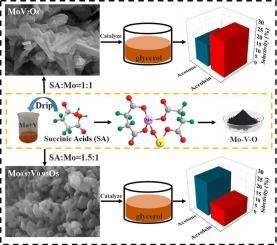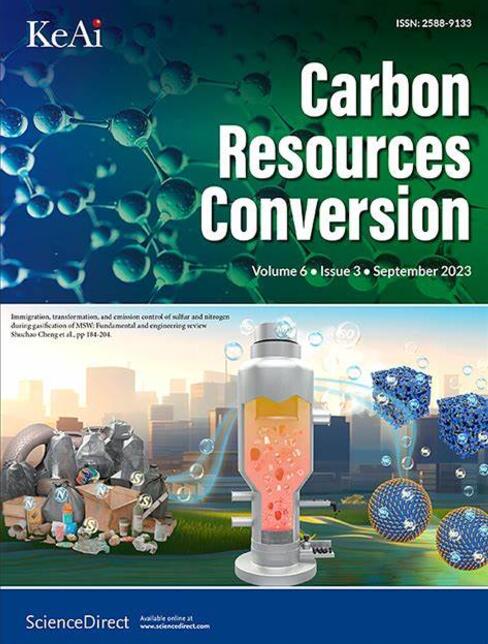多碱性有机酸控制合成用于甘油催化转化的 Mo-V-O 复合金属氧化物
IF 7.5
3区 环境科学与生态学
Q2 ENERGY & FUELS
引用次数: 0
摘要
通过将草酸、琥珀酸和酒石酸引入到Mo-V-O复合金属氧化物的合成过程中,研究了多碱性有机酸对Mo-V-O复合金属氧化物晶体结构的结构导向作用。并将制备的不同晶相组成的Mo-V-O样品用于甘油的转化,考察了晶相结构对其催化性能的影响。结果表明,通过改变多碱性有机酸的种类和添加量,可以调节Mo-V-O的晶相结构。随着琥珀酸和酒石酸含量的增加,Mo-V-O的晶相由MoV2O8变为Mo0.97V0.95O5。Mo-V-O晶相的变化与有机酸的加入量和碳链长度有关。当晶相为MoV2O8时,丙烯醛和丙酮的选择性分别为25.7%和16.2%。XPS结果表明,mo2o8中的Mo6+促进了丙烯醛的生成,Mo0.97V0.95O5中的Mo5+促进了丙酮的生成。因此,当晶相为Mo0.97V0.95O5时,丙烯醛和丙酮的选择性分别为11.9%和24.6%。因此,可以通过选择不同的晶相来控制催化甘油的结果。本文章由计算机程序翻译,如有差异,请以英文原文为准。

Polybasic organic acids controlled synthesis of Mo-V-O composite metal oxide for the catalytic conversion of glycerol
By introducing oxalic acid, succinic acid, and tartaric acid into the synthesis process of Mo-V-O composite metal oxides, the structure directing effect of polybasic organic acids on the crystal structure of Mo-V-O compositee metal oxide was studied. Moreover, the prepared Mo-V-O samples with different crystal phase compositions were used to the conversion of glycerol, and the effect of crystal phase structure on its catalytic performance was investigated. Results show that the crystal phase structure of Mo-V-O can be regulated by changing the type and additive amount of polybasic organic acids. The crystal phase of Mo-V-O changed from MoV2O8 to Mo0.97V0.95O5 with the increase of succinic acid and tartaric acid. The change in the Mo-V-O crystal phase is related to the amount of organic acid and the carbon chain length. When the crystal phase is MoV2O8, the selectivity of acrolein and acetone is 25.7 % and 16.2 %. According to the XPS results, Mo6+ in MoV2O8 promoted the formation of acrolein, while Mo5+ in Mo0.97V0.95O5 promoted the formation of acetone. So when the crystal phase is Mo0.97V0.95O5, the selectivity of acrolein and acetone is 11.9 % and 24.6 %. Therefore, the results of catalyzing glycerol can be controlled by selecting different crystal phases.
求助全文
通过发布文献求助,成功后即可免费获取论文全文。
去求助
来源期刊

Carbon Resources Conversion
Materials Science-Materials Science (miscellaneous)
CiteScore
9.90
自引率
11.70%
发文量
36
审稿时长
10 weeks
期刊介绍:
Carbon Resources Conversion (CRC) publishes fundamental studies and industrial developments regarding relevant technologies aiming for the clean, efficient, value-added, and low-carbon utilization of carbon-containing resources as fuel for energy and as feedstock for materials or chemicals from, for example, fossil fuels, biomass, syngas, CO2, hydrocarbons, and organic wastes via physical, thermal, chemical, biological, and other technical methods. CRC also publishes scientific and engineering studies on resource characterization and pretreatment, carbon material innovation and production, clean technologies related to carbon resource conversion and utilization, and various process-supporting technologies, including on-line or off-line measurement and monitoring, modeling, simulations focused on safe and efficient process operation and control, and process and equipment optimization.
 求助内容:
求助内容: 应助结果提醒方式:
应助结果提醒方式:


